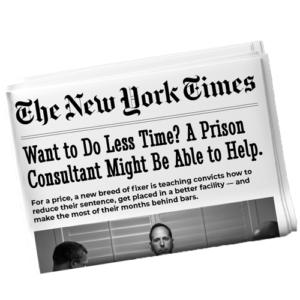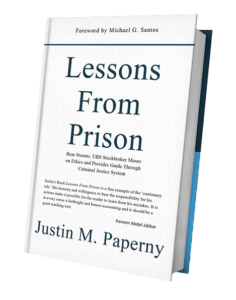Hi, I am Justin Paperny, Co-Founder of White Collar Advice. Michael Santos and I wrote this book and chose to give it away to those willing to help themselves. This is about you, not me. If you want to learn more about my journey, go here. Now, let’s get going with Chapter 1.
Our answer to the first question is simple: A lot!
Many people facing law-enforcement challenges make decisions that exacerbate their problems. They don’t mean to make matters worse, but they become vulnerable without understanding what’s coming, their options, or where to turn for reliable information.
Targets of government or criminal investigations can unwittingly talk themselves into a criminal indictment. They may eliminate opportunities for diversion from prosecution or expose themselves to tougher sanctions.
Competent legal counsel is essential. But if an individual doesn’t have experience with criminal law, a primer on the system may help. With more knowledge, a person will feel more competent when working with a criminal lawyer. Without knowledge, people will always feel like they’re operating in darkness, never knowing what’s around the next turn.
By learning about the criminal justice system, a person can arm themselves to work more effectively with lawyers. They may understand how to resolve complex dilemmas better. Although the choices may be limited, confidence in making the best possible decision increases when a person understands context, opportunity costs, and ramifications.
As an old Chinese proverb says: If you want to know the road ahead, ask someone who has come back.
Investing time and energy in learning makes excellent sense when under the spotlight of a white-collar criminal investigation. By learning, a person can make more informed decisions. Operating without knowledge feels like hanging from a string, like marionette puppets. To stop that helpless feeling and restore confidence, we need to learn and make deliberate decisions that will influence the best possible outcomes.
The first step is to acquire knowledge and become more literate about the system. As the cliché holds, the greatest fear is the fear of the unknown.
Defendants quickly learn that problems with the criminal justice system can lead to enormous costs. It isn’t only money that’s at stake. Liberty is at stake. Future earning power is at stake. Collateral consequences—like access to banking, housing, and career opportunities—can linger for a lifetime. Preparing makes a great deal of sense.
Many people get sucked into the criminal justice system. Although going through the system is complex, there are best-practice ways to prepare.
By learning more about the system, you can position yourself for a better outcome. Using good critical thinking skills, targets or defendants may influence decision-makers to view them through a more empathetic lens, as human beings rather than just cogs in a criminal justice machine.
All people facing challenges with the criminal justice system share common traits. Their family members, friends, and colleagues care about them. Defendants want investigators, prosecutors, probation officers, and judges to see them as ordinary citizens. They may have been charged with a crime, but defendants, like all people, have many attributes that reflect their character. A crime may be an aberration, a one-time act that doesn’t resemble their usual behavior.
Yet once the criminal justice system targets people for prosecution, stakeholders focus on the alleged criminal wrongdoing. A criminal charge can prevent stakeholders from seeing an individual as a human being. In an instant, the person becomes a defendant. The goal, or objective, is only sometimes justice. It’s a conviction followed by a punitive sanction.
Targets of a white-collar criminal investigation want to find some diversionary program to avoid federal or state prosecution. If they’re prosecuted, they want the best possible outcome, which usually means the least restrictive or least punitive sanction—preferably a sentence that does not include incarceration.
But how does a person go about getting the best outcome? Unfortunately, few people who encounter the criminal justice system know how to position themselves for the best possible result.
As Yogi Berra said, “If you don’t know where you’re going, you’ll end up someplace else.”
Overview: Relatively few Americans have more than a basic understanding of our nation’s criminal justice system. On the surface, people know that law enforcement officers arrest people, prosecutors bring charges, and some defendants who are convicted go to jail or prison. Yet the system is much more complicated than that, with many moving parts.
White-Collar Criminal Investigations: Targets should begin from the premise that the system has one function: to protect society. It has a series of procedures designed to enforce the laws of this country.
All branches of law enforcement work together to prosecute crimes. Just as some offenders will make every effort to evade detection and apprehension by law enforcement, different members of law enforcement will make every effort to solve a crime and win a conviction.
As citizens, we are all charged with the responsibility of abiding by our nation’s laws. Legislators pass the bills, and heads of state sign them into law. The criminal justice system is responsible for enforcing these laws.
Few people understand that our country has 53 separate criminal justice systems, including one for each state, one for the District of Columbia, one for the military, and one for the federal government. Within the different systems are hundreds of jurisdictions, each with a series of trial courts that make findings of fact. Higher courts may review whether trial courts followed accepted procedures.
This elaborately complex system has evolved over hundreds of years. For a person who enters the system, it can feel like being dropped into a byzantine labyrinth, with so many turns and dimensions that make it easy to lose direction.
To put this into perspective, consider the system a zero-sum game. We use the metaphor of a game for clarity, not to trivialize the conflict between the accused and the accuser. Defendants are the opponents of investigators and prosecutors. Both sides want to win. The defendants want to be diverted from prosecutions, acquitted, or receive the least restrictive sanction. Law enforcement officers want to convict. Prosecutors want to ensure that the defendants receive what they deem as an appropriate sanction.
The judge acts as a referee in this “game” of criminal justice.
Judges strive to ensure that both sides of the game adhere to the rules or due process. They must follow established procedures within the system. In some instances, juries will determine the outcome of this game. But in most cases, defendants will plead guilty before a judge. Then, the long game begins with post-conviction proceedings. They include a pre-sentence investigation and a sentencing hearing. Classification processes follow. For some, the next step includes appeals, imprisonment, supervised release, and all collateral consequences that stay with the “felon” class.
The sooner a target or a defendant starts preparing, the more influence that person can have on a better outcome.
As Mick Jagger sang, we don’t always get what we want. But if we try sometimes, we just might find, we get what we need.
To get what we need, we must work well with a criminal defense attorney. The more we know about what is to come, the better we prepare ourselves to help our lawyers get us the best outcome. For example, if we know what follows in federal prison, we may better understand the impact of a plea agreement or a prison term. In all cases, knowledge can help us make more informed decisions and restore confidence.
If you need to hire or replace your existing lawyer, visit topwca.com.
Schedule a call with our team to gain more insight and prepare effectively.
Join our weekly webinar every Monday at 1 PM Pacific / 4 PM Eastern to stay informed and empowered.
In the next chapter, we’ll cover some thoughts on working with a criminal defense attorney.
Best,
Justin Paperny
P.S. To learn more about the value of preparing, watch my video with Dr. Nate Schott. Instead of 63 months in prison, he received 33 months and was released after ten months.




